Related Research Articles
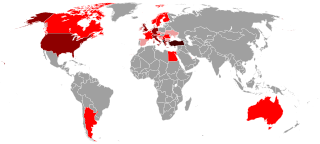
The Albanians are an ethnic group native to the Balkan Peninsula who share a common Albanian ancestry, culture, history and language. They are the main ethnic group of Albania and Kosovo, and they also live in the neighboring countries of North Macedonia, Montenegro, Greece, and Serbia, as well as in Italy, Croatia, Bulgaria, and Turkey. Albanians also constitute a large diaspora with several communities established across Europe and the other continents.

Korçë District, was one of the 36 districts of Albania, which were dissolved in July 2000 and replaced by 12 counties. It had a population of 143,499 in 2001, and an area of 1,752 km2 (676 sq mi). Its capital was the city of Korçë. Its territory is now part of Korçë County: the municipalities of Korçë, Maliq and Pustec.
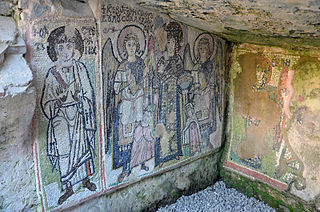
Durrës is the second-most-populous city of the Republic of Albania and seat of Durrës County and Durrës Municipality. It is one of Albania's oldest continuously inhabited cities, with roughly 2,500 years of recorded history. It is located on a flat plain along the Albanian Adriatic Sea Coast between the mouths of the Erzen and Ishëm at the southeastern corner of the Adriatic Sea. Durrës' climate is profoundly influenced by a seasonal Mediterranean climate.

When the Roman Empire divided into east and west in 395, the territories of modern Albania became a part of the Byzantine Empire. At the end of the 12th century, the Principality of Arbanon was formed which lasted until mid 13th century, after its dissolution it was followed with the creation of the Albanian Kingdom after an alliance between the Albanian noblemen and Angevin dynasty. After a war against the Byzantine empire led the kingdom occasionally decrease in size until the Angevins eventually lost their rule in Albania and led the territory ruled by several different Albanian chieftains until the mid 14th century which for a short period of time were conquered by the short-lived empire of Serbia. After its fall in 1355 several chieftains regained their rule and significantly expanded until the arrival of the Ottomans after the Battle of Savra.

The Aromanians are an ethnic group native to the southern Balkans who speak Aromanian, an Eastern Romance language. They traditionally live in central and southern Albania, south-western Bulgaria, northern and central Greece and North Macedonia, and can currently be found in central and southern Albania, south-western Bulgaria, south-western and eastern North Macedonia, northern and central Greece, southern Serbia and south-eastern Romania. An Aromanian diaspora living outside these places also exists. The Aromanians are known by several other names, such as "Vlachs" or "Macedo-Romanians".

Ohrid is a city in North Macedonia and is the seat of the Ohrid Municipality. It is the largest city on Lake Ohrid and the eighth-largest city in the country, with the municipality recording a population of over 42,000 inhabitants as of 2002. Ohrid is known for once having 365 churches, one for each day of the year, and has been referred to as the "Jerusalem of the Balkans". The city is rich in picturesque houses and monuments, and tourism is predominant. It is located southwest of Skopje, west of Resen and Bitola. In 1979 and in 1980, respectively, Ohrid and Lake Ohrid were accepted as Cultural and Natural World Heritage Sites by UNESCO. Ohrid is one of only 28 sites that are part of UNESCO's World Heritage that are Cultural as well as Natural sites.

Moscopole or Voskopoja is a village in Korçë County in southeastern Albania. During the 18th century, it was the cultural and commercial center of the Aromanians. At its peak, in the mid 18th century, it hosted the first printing house in the Ottoman Balkans outside Constantinople, educational institutions and numerous churches. It became a leading center of Greek culture but also with elements of Albanian and Aromanian culture, all with great influence from Western civilization.
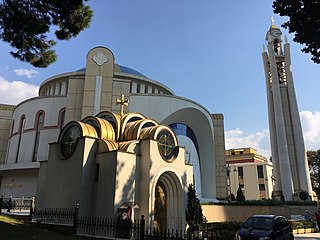
The Autocephalous Orthodox Church of Albania, commonly known as the Albanian Orthodox Church or the Orthodox Church of Albania, is an autocephalous Eastern Orthodox church. It declared its autocephaly in 1922 through its Congress of 1922, and gained recognition from the Patriarch of Constantinople in 1937.

The Monastery of Saint Naum is a Macedonian Orthodox monastery. It is named after the medieval Bulgarian writer and enlightener Saint Naum who founded it. The monastery is situated in North Macedonia, along Lake Ohrid, 29 kilometres (18 mi) south of the city of Ohrid, within the boundary of the village of Ljubaništa.
The Elbasan alphabet is a mid 18th-century alphabetic script created for the Albanian language Elbasan Gospel Manuscript, also known as the Anonimi i Elbasanit, which is the only document written in it. The document was created at St. Jovan Vladimir's Church in central Albania, but is preserved today at the National Archives of Albania in Tirana. The alphabet, like the manuscript, is named after the city of Elbasan, where it was invented, and although the manuscript isn't the oldest document written in Albanian, Elbasan is the oldest out of seven known original alphabets created for Albanian. Its 59 pages contain Biblical content written in a script of 40 letters, of which 35 frequently recur and 5 are rare.
The Greeks in Albania are ethnic Greeks who live in or originate from areas within modern Albania. They form the largest minority group in the country. They are mostly concentrated in the south of the country, in the areas of the northern part of the historical region of Epirus, in parts of Vlorë County, Gjirokastër, Korçë, and Berat County. The area is also known as Northern Epirus. Consequently, the Greeks hailing specifically from Southern Albania are also known as Northern Epirotes. The Greeks who live in the "minority zones" of Albania are officially recognised by the Albanian government as the Greek National Minority of Albania.
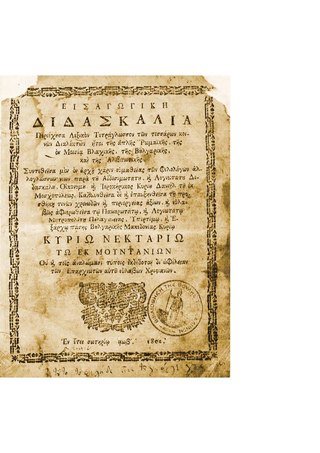
Daniel of Moscopole or Daniil of Moscopole, also known as Mihali Adami Hagi, was an Aromanian scholar from Moscopole and student of Theodoros Kavalliotis, an 18th/19th-century professor and director of New Academy of Moscopole.
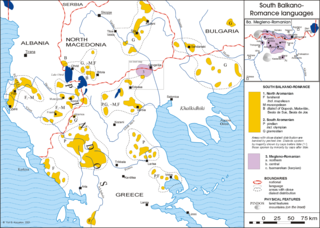
The Aromanian language, also known as Vlach or Macedo-Romanian, is an Eastern Romance language, similar to Megleno-Romanian, Istro-Romanian and Romanian, spoken in Southeastern Europe. Its speakers are called Aromanians or Vlachs.
Theodore Anastasios Kavalliotis was a Greek Orthodox priest, teacher and a figure of the Greek Enlightenment. He is also known for having drafted an Aromanian–Greek–Albanian dictionary.

The Monastery of the Nativity of the Theotokos in Ardenica (Albanian: Manastiri Lindja e Hyjlindëses Mari,; or simply Ardenica Monastery is an Eastern Orthodox monastery, located 18 kilometers south of Lushnjë, Albania, along the national road that links Lushnjë to Fier.
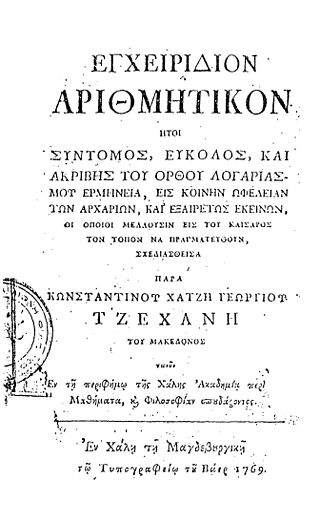
Konstantinos Tzechanis was a philosopher, mathematician and poet from the 18th century Aromanian center of Moscopole.

The New Academy or Greek Academy was a renowned educational institution, operating from 1743 to 1769 in Moscopole, an 18th-century cultural and commercial metropolis of the Aromanians and leading center of Greek culture in what is now southern Albania. It was nicknamed the "worthiest jewel of the city" and played a very active role in the inception of the modern Greek Enlightenment movement.
The Islamization of Albania occurred as a result of the Ottoman conquest of the region beginning in 1385. The Ottomans through their administration and military brought Islam to Albania.

Gregory of Durrës was an Albanian scholar, printer, typographer, teacher, and Eastern Orthodox Christian monk and cleric of Ottoman Albania who is thought to have invented a particular Albanian alphabetic script, the Elbasan script, used to write the Elbasan Gospel Manuscript. The manuscript is one of the oldest known pieces of Albanian Orthodox literature, as well as the oldest known Orthodox Bible translation into Albanian.
The Aromanian diaspora is any ethnically Aromanian population living outside its traditional homeland in the Balkans. The Aromanians are a small Balkan ethnic group living scattered throughout Albania, Bulgaria, Greece, North Macedonia, Romania and Serbia. Historically, they also used to live in other countries such as Bosnia and Herzegovina and Croatia, although they have ever since been assimilated.
References
- ↑ "Moscopole was the cultural center of the Aromanians – Assembly of European Regions". aer.eu. 5 January 2016. Retrieved 16 October 2024.
- ↑ Greek, Roman and Byzantine studies. Duke University. 1981. p. 90.
- ↑ Elsie, Robert. "GREGORY OF DURRËS". Archived from the original on 13 January 2012.
- ↑ Lloshi, Xhevat (2008). Rreth Alfabetit te shqipes [Around the Albanian Alphabet)] (in Albanian). Logos. p. 103. ISBN 978-9989-58-268-4 . Retrieved 1 June 2010.
- 1 2 Mikropoulos, Tassos A. (2008). Elevating and Safeguarding Culture Using Tools of the Information Society: Dusty traces of the Muslim culture. Earthlab. pp. 315–316. ISBN 978-960-233-187-3.
- ↑ Kekridis Eustathios (1989). Θεόδωρος Αναστασίου Καβαλλιώτης (1718; 1789). Ο Διδάσκαλος του Γένους (Thesis) (in Greek and English). Aristotle University of Thessaloniki. p. 44. doi:10.12681/eadd/1624 . Retrieved 11 September 2010.
- ↑ Detrez, Raymond (15 July 2013). Entangled Histories of the Balkans - Volume One: National Ideologies and Language Policies. BRILL. p. 52. ISBN 978-90-04-25076-5.
- ↑ Yll Rugova (2022). Tipografia shqiptare 1555–1912, p. 130–131. "The press of Moscopole must have operated between 1731 and 1760. We know for sure 20 volumes printed there, of which today 189 copies are kept in different collections and libraries."
